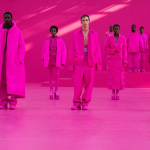
Who wears "macho pink"?
When a colour becomes a statement
May 16th, 2022
The colour strategy undertaken by Pierpaolo Piccioli for the autumn prêt-à-porter is definitely paying off: not only, according to statistics, is 'macho pink' the favourite colour of this year's men's fashion, but what is even more surprising is the geographical epicentre of the trend that has been invading social networks and red carpets for some time now: China. 81 monochromatic looks in a vibrant pink, worn indiscriminately by women and men, and soon after by international celebrities - from Zendaya to Billy Porter, Trevor Noah, Travis Barker, Justin Bieber passing through the Italian star system, Laura Pausini or the duo Mahmood and Blanco. Thanks to a ubiquitous communication strategy that even brought Sebastian Stan to the Met in a total Valentino look despite the outfit not adhering at all to this year's theme, and the challenge launched by TikTok in September 2020 inviting users to show off their version of an outfit #MachoPink, the hashtag received 130 million views.
Searches for the new shade have gained ground throughout 2021, while on the Dewu platform, which has mainly male customers, pink trainers are trending so much that Xiaohongshu users have posted more than 70,000 times on the subject. A colour that is also conquering e-sports, marking a change in the aesthetics of male consumers. In line with other parts of the world, men in China are increasingly willing to wear pink, changing norms and opening up a new opportunity for brands to target a more adventurous clientele. It is no coincidence that the trend is more entrenched in China than elsewhere, a country where for years a dictatorial political regime and laws against those who choose to adopt an aesthetic that does not conform to the government-promoted idea of masculinity have led to a common interest in a rebellion that is embodied in clothing. Jenny Clark, colour director of forecasting agency WGSN, said that 'millennial pink' had become the key colour of the moment: gender neutral, a symbol of youth and fun, as well as versatility.
If a few years ago the colour gradient that came to mind when thinking of Valentino was red, today it is the pink of Pier Paolo Piccioli. Perhaps carmine, but not purple or even fiery red, the Valentino red has for years been a trademark determined by a very precise chromatic formula: a mixture that calibrates 100% magenta, 100% yellow with just 10% black. Legend has it that Garavani, during his years in Paris, was so fascinated by the solemn atmosphere of the Barcelona Opera, including the guests dressed in red, that he made the shade the distinctive symbol of all his collections. The operation carried out by Piccioli is a generational revolution that also becomes a chromatic one: from classic red - elegant, iconic but closely linked to the world of women and to a segment of more adult consumers - to the shocking pink of the past collections. A vibrant colour that like red takes on an emotional dimension, but also a social statement that speaks of inclusiveness and equality, as well as Gen Z.




































































